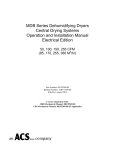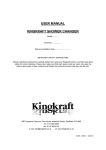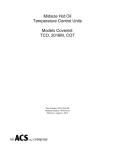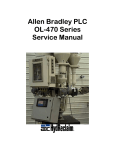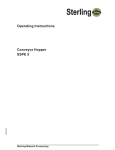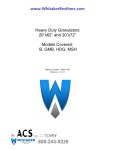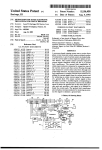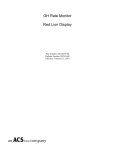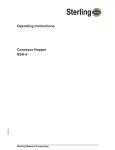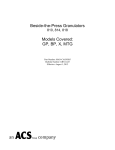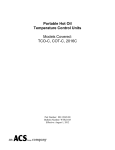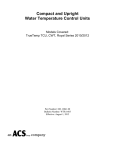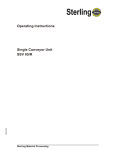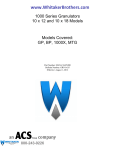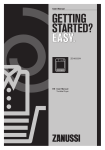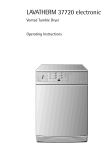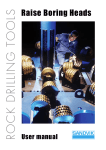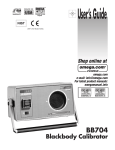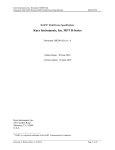Download User Manual
Transcript
HA-F Hot Air Dryer Effective: 5/15/15 Part Number: 882.03122.00 Bulletin Number: DRY2-605.00 Write Down Your Serial Numbers Here For Future Reference: _________________________ _________________________ _________________________ _________________________ _________________________ _________________________ We are committed to a continuing program of product improvement. Specifications, appearance, and dimensions described in this manual are subject to change without notice. DCN No. ____________ © Copyright 2015 All rights reserved. Hot Air Dryers ii Shipping Info Unpacking and Inspection You should inspect your dryer for possible shipping damage. Thoroughly check the equipment for any damage that might have occurred in transit, such as broken or loose wiring and components, loose hardware and mounting screws, etc. In the Event of Shipping Damage According to the contract terms and conditions of the Carrier, the responsibility of the Shipper ends at the time and place of shipment. Notify the transportation company’s local agent if you discover damage. Hold the damaged goods and packing material for the examining agent’s inspection. Do not return any goods before the transportation company’s inspection and authorization. File a claim with the transportation company. Substantiate the claim by referring to the agent’s report. A certified copy of our invoice is available upon request. The original Bill of Lading is attached to our original invoice. If the shipment was prepaid, write us for a receipted transportation bill. Advise customer service regarding your wish for assistance and to obtain an RMA (return material authorization) number. If the Shipment is Not Complete Check the packing list as back-ordered items are noted on the packing list. You should have: þ Hot Air Dryer þ Bill of lading þ Packing list þ Operating and Installation packet þ Electrical schematic and panel layout drawings þ Component instruction manuals Re-inspect the container and packing material to see if you missed any smaller items during unpacking. If the Shipment is Not Correct If the shipment is not what you ordered, contact the shipping department immediately. For immediate assistance, please contact the correct facility located in the technical assistance section of this manual. Have the order number and item number available. Hold the items until you receive shipping instructions. Returns Do not return any damaged or incorrect items until you receive shipping instructions from the shipping department. Hot Air Dryers iii Credit Returns Prior to the return of any material authorization must be given by the manufacturer. A RMA number will be assigned for the equipment to be returned. Reason for requesting the return must be given. ALL returned material purchased from the manufacturer returned is subject to 15% ($75.00 minimum) restocking charge. ALL returns are to be shipped prepaid. The invoice number and date or purchase order number and date must be supplied. No credit will be issued for material that is not within the manufacturer’s warranty period and/or in new and unused condition, suitable for resale. Warranty Returns Prior to the return of any material, authorization must be given by the manufacturer. A RMA number will be assigned for the equipment to be returned. Reason for requesting the return must be given. All returns are to be shipped prepaid. The invoice number and date or purchase order number and date must be supplied. After inspecting the material, a replacement or credit will be given, at the manufacturer’s discretion. If the item is found to be defective in materials or workmanship, and it was manufactured by our company, purchased components are covered under their specific warranty terms. Hot Air Dryers iv Table of Contents CHAPTER 1: SAFETY................................................................ 6 1-1 1-2 1-3 How to Use This Manual ...........................................................................................................6 Safety Symbols Used in this Manual ................................................................................. 6 Warnings and Precautions ........................................................................................................8 Responsibility ............................................................................................................................9 General Responsibility ....................................................................................................... 9 Operator Responsibility...................................................................................................... 9 Maintenance Responsibility ............................................................................................. 11 Reporting a Safety Defect ................................................................................................ 11 CHAPTER 2: FUNCTIONAL DESCRIPTION ........................... 12 2-1 2-2 2-3 2-4 2-5 Models Covered in This Manual ..............................................................................................12 Equipment Function ................................................................................................................12 Necessary Documents ............................................................................................................12 Standard Features ...................................................................................................................13 Optional Features ....................................................................................................................13 CHAPTER 3: INSTALLATION ................................................. 14 3-1 3-2 3-3 Work Rules ..............................................................................................................................14 Installation Location Considerations ........................................................................................14 Hose Connection ............................................................................................................. 14 Making Electrical Connections ................................................................................................14 Power Drop ...................................................................................................................... 15 Blower Motor Rotation ..................................................................................................... 15 CHAPTER 4: STARTUP AND OPERATION............................ 16 4-1 4-2 4-3 4-4 4-5 4-6 Introduction ..............................................................................................................................16 Pre-Startup Checklist ..............................................................................................................16 Starting the Dryer ....................................................................................................................16 Air Adjustment .........................................................................................................................16 Shutting Down the Dryer .........................................................................................................16 Drying Non-Hygroscopic Materials ..........................................................................................17 CHAPTER 5: MAINTENANCE ................................................. 18 5-1 5-2 5-3 5-4 Maintaining Blower Motors ......................................................................................................18 Cleaning the Cartridge Filters ..................................................................................................18 Temperature Safety Set Point .................................................................................................18 Replacing the Heater Element ................................................................................................18 CHAPTER 6: TROUBLESHOOTING ....................................... 20 CHAPTER 7: APPENDIX ......................................................... 22 7-1 Technical Assistance ...............................................................................................................22 Parts Department ............................................................................................................. 22 Service Department ......................................................................................................... 22 Sales Department ............................................................................................................ 22 Contract Department........................................................................................................ 22 Hot Air Dryers v Chapter 1: Safety 1-1 How to Use This Manual Use this manual as a guide and reference for installing, operating, and maintaining your dryer. The purpose is to assist you in applying efficient, proven techniques that enhance equipment productivity. This manual covers only light corrective maintenance. No other maintenance should be undertaken without first contacting a service engineer. The Functional Description section outlines models covered, standard features, and safety features. Additional sections within the manual provide instructions for installation, preoperational procedures, operation, preventive maintenance, and corrective maintenance. The Installation chapter includes required data for receiving, unpacking, inspecting, and setup of the dryer. We can also provide the assistance of a factory-trained technician to help train your operator(s) for a nominal charge. This section includes instructions, checks, and adjustments that should be followed before commencing with operation of the dryer. These instructions are intended to supplement standard shop procedures performed at shift, daily, and weekly intervals. The Operation chapter includes a description of electrical and mechanical controls, in addition to information for operating the dryer safely and efficiently. The Maintenance chapter is intended to serve as a source of detailed assembly and disassembly instructions for those areas of the equipment requiring service. Preventive maintenance sections are included to ensure that your dryer provides excellent, long service. The Troubleshooting chapter serves as a guide for identification of most common problems. Potential problems are listed, along with possible causes and related solutions. The Appendix contains technical specifications, drawings, schematics, parts lists, and available options. A spare parts list with part numbers specific to your machine is provided with your shipping paperwork package. Refer to this section for a listing of spare parts for purchase. Have your serial number and model number ready when ordering. Safety Symbols Used in this Manual The following safety alert symbols are used to alert you to potential personal injury hazards. Obey all safety messages that follow these symbols to avoid possible injury or death. DANGER indicates an imminently hazardous situation that, if not avoided, will result in death or serious injury. WARNING indicates a potentially hazardous situation or practice that, if not avoided, could result in death or serious injury. CAUTION indicates a potentially hazardous situation or practice that, if not avoided, may result in minor or moderate injury or in property damage. Hot Air Dryers Chapter 1: Safety 6 of 23 Dryer Safety Tags Hazard Alert Symbol Mandatory Symbol Description/Explanation Preventative Maintenance High Voltage Hazard. The electrical enclosure is supplied with 3-phase electrical power. Use caution when using or maintaining this product. Hot Surface Hazard. When the unit operates above 212F (100C) the surface of the unit may reach excessive temperatures. Use caution when using or maintaining this product. Every six months inspect all electrical connections for secure attachment. For further information see the Maintenance Chapter in this manual Every six months inspect all surfaces for signs of heat degradation. If any appear remove panel and verify cause of degradation and repair. Description/Explanation Read Operators Manual. This equipment must be operated and maintained by properly trained personnel. The information contained within this manual must be read and understood prior to operating this equipment. Lock Out. This equipment is operated with 3-phase electrical power. Therefore, when performing any maintenance operations we recommend following the local standards for performing a lock-out/tag-out procedure. Hot Air Dryers Chapter 1: Safety 7 of 23 1-2 Warnings and Precautions Our dryers are designed to provide safe and reliable operation when installed and operated within design specifications, following national and local safety codes. To avoid possible personal injury or equipment damage when installing, operating, or maintaining this dryer, use good judgment and follow these safe practices: þ Read and follow these operation and installation instructions when installing, operating, and maintaining this equipment. If these instructions become damaged or unreadable, additional copies are available from the manufacturer. þ Follow all SAFETY CODES. þ Wear SAFETY GLASSES and WORK GLOVES. þ Disconnect and/or lock out power before servicing or maintaining the hot air dryers þ Use care when LOADING, UNLOADING, RIGGING, or MOVING this equipment. þ Operate this equipment with design specifications. þ OPEN, TAG, and LOCK ALL DISCONNECTS before working on equipment. You should remove the fuses and carry them with you. þ Make sure the hot air dryers and components are properly GROUNDED before you switch on power. þ Do not jump or bypass any electrical safety control. þ Do not restore power until you remove all tools, test equipment, etc. and the hot air dryers and related equipment are fully reassembled. þ Only PROPERLY TRAINED personnel familiar with the information in this manual should work on this equipment. We have long recognized the importance of safety and have designed and manufactured our equipment with operator safety as a prime consideration. We expect you, as a user, to abide by the foregoing recommendations in order to make operator safety a reality. Hot Air Dryers Chapter 1: Safety 8 of 23 1-3 Responsibility These machines are constructed for maximum operator safety when used under standard operating conditions and when recommended instructions are followed in the maintenance and operation of the machine. All personnel engaged in the use of the machine should become familiar with its operation as described in this manual. Proper operation of the machine promotes safety for the operator and all workers in its vicinity. Becoming familiar with materials, inspection, speed limitations, screens, and guard maintenance and total user responsibility will assist you in learning potential areas in need of observation for danger. Each individual must take responsibility for observing the prescribed safety rules as outlined. All caution, warning and danger signs must be observed and obeyed. All actual or potential danger areas must be reported to your immediate supervisor. General Responsibility No matter who you are, safety is important. Owners, operators and maintenance personnel must realize that every day, safety is a vital part of their jobs. If your main concern is loss of productivity, remember that production is always affected in a negative way following an accident. The following are some of the ways that accidents can affect your production: • Loss of a skilled operator (temporarily or permanently) • Breakdown of shop morale • Costly damage to equipment • Downtime An effective safety program is responsible and economically sound. Organize a safety committee or group, and hold regular meetings. Promote this group from the management level. Through this group, the safety program can be continually reviewed, maintained, and improved. Keep minutes or a record of the meetings. Hold daily equipment inspections in addition to regular maintenance checks. You will keep your equipment safe for production and exhibit your commitment to safety. Please read and use this manual as a guide to equipment safety. This manual contains safety warnings throughout, specific to each function and point of operation. Operator Responsibility The operator’s responsibility does not end with efficient production. The operator usually has the most daily contact with the equipment and intimately knows its capabilities and limitations. Plant and personnel safety is sometimes forgotten in the desire to meet incentive rates, or through a casual attitude toward machinery formed over a period of months or years. Your employer probably has established a set of safety rules in your workplace. Those rules, this manual, or any other safety information will not keep you from being injured while operating your equipment. Hot Air Dryers Chapter 1: Safety 9 of 23 Learn and always use safe operation. Cooperate with co-workers to promote safe practices. Immediately report any potentially dangerous situation to your supervisor. þ NEVER place your hands or any part of your body in any dangerous location. þ NEVER operate, service, or adjust the dryer without appropriate training and first reading and understanding this manual. þ NEVER try to pull material out of the dryer with your hands while it is running! þ Before you start the dryer, check the following: • Remove all tools from the dryer; • Be sure no objects (tools, nuts, bolts, clamps, bars) are laying in the area; þ If your dryer has been inoperative or unattended, check all settings before starting. þ At the beginning of your shift and after breaks, verify that the controls and other auxiliary equipment are functioning properly. þ Keep all safety guards in place and in good repair. NEVER attempt to bypass, modify, or remove safety guards. Such alteration is not only unsafe, but will void the warranty on your equipment. þ When changing control settings to perform a different mode of operation, be sure selector switches are correctly positioned. Locking selector switches should only be adjusted by authorized personnel and the keys removed after setting. þ Report the following occurrences IMMEDIATELY: unsafe operation or condition unusual dryer action leakage improper maintenance NEVER stand or sit where you could slip or stumble into the dryer while working on it. þ DO NOT wear loose clothing or jewelry, which can be caught while working on the dryer. In addition, cover or tie back long hair. • • • • • þ Clean the dryer and surrounding area DAILY, and inspect the machine for loose, missing or broken parts. þ Shut off power to the dryer when it is not in use. Turn the switch to the OFF position, or unplug it from the power source. Hot Air Dryers Chapter 1: Safety 10 of 23 Maintenance Responsibility Proper maintenance is essential to safety. If you are a maintenance worker, you must make safety a priority to effectively repair and maintain equipment. Before removing, adjusting, or replacing parts on a machine, remember to turn off all electric supplies and all accessory equipment at the machine, and disconnect and lockout electrical and pneumatic power. Attach warning tags to the disconnect switch and air shutoff valve. When you need to perform maintenance or repair work on a dryer above floor level, use a solid platform or a hydraulic elevator. If there is a permanently installed catwalk on your dryer, use it. The work platform should have secure footing and a place for tools and parts. DO NOT climb on the dryer, machines, or work from ladders. If you need to repair a large component, use appropriate handling equipment. Before you use handling equipment (portable “A” frames, electric boom trucks, fork trucks, overhead cranes) be sure the load does not exceed the capacity of the handling equipment or cause it to become unstable. Carefully test the condition of lifting cables, chains, ropes, slings, and hooks before using them to lift a load. Be sure that all non-current carrying parts are correctly connected to earth ground with an electrical conductor that complies with current codes. Install in accordance with national and local codes. When you have completed the repair or maintenance procedure, check your work and remove your tools, rigging, and handling equipment. Do not restore power to the dryer until all persons are clear of the area. DO NOT start and run the dryer until you are sure all parts are functioning correctly. BEFORE you turn the dryer over to the operator for production, verify all enclosure panels, guards and safety devices are in place and functioning properly. Reporting a Safety Defect If you believe that your equipment has a defect that could cause injury, you should immediately discontinue its use and inform the manufacturer. The principle factors that can result in injury are failure to follow proper operating procedures (i.e. lockout/tagout), or failure to maintain a clean and safe working environment. Hot Air Dryers Chapter 1: Safety 11 of 23 Chapter 2: Functional Description 2-1 Models Covered in This Manual This manual provides all necessary information for installing, operating, and maintaining the HA-F 750. The HA/SHA/CHA Series Hot Air Dryers come in model numbers from 85 to 4000 models. The dryer number designation represents air flow capacity. Figure 1: Hot Air Dryer Air Flow Capacity 2-2 Model Number SCFM SCMH 85 85 144 125 125 212 185 185 314 225 225 382 400 400 680 600 600 1019 750 750 1274 1000 1000 1699 1200 1200 2039 1500 1500 2549 2000 2000 3398 2500 2500 4248 3000 3000 5097 4000 4000 6796 Equipment Function Hot air dryers are designed to deliver heated air to a drying hopper to drive moisture of the surface of plastic pellets. Hot air dryers are sized to meet the specific requirements stated by the purchaser at the time of purchase. Hot air dryers are used to deliver between 85 and 4000 scfm (see above figure) at temperatures up to 250˚ F (121˚ C). 2-3 Necessary Documents The documents listed below are necessary for the operation, installation, and maintenance of hot air dryers. Additional copies are available from the manufacturer. Make sure that the appropriate personnel are familiar with these documents: Hot Air Dryers • This manual. • The schematic and connection diagram in the control enclosure. • The operation and installation manuals for accessories and options selected by the customer. Chapter 2: Functional Description 12 of 23 2-4 Standard Features þ Regenerative (85-225 scfm units) or centrifugal blower (400-4000 scfm units) þ NEMA 1, standard 460/3/60 control panel þ Built-in duel safety þ Duel set point process temperature control to 250˚ F (121˚ C) þ Contactors on process heaters þ Electrical disconnect þ Fusing þ Two (2) clamps þ One (1) thermocouple þ One 12 foot (3.6 m) length of high temperature dryer hose þ 460/3/60 supply voltage þ Manual Butterfly valve on inlet to adjust airflow 2-5 Optional Features Options are available to match your hot air dryer with your specific drying requirements. þ Special voltages are available to match the power supply of your facility. Hot Air Dryers Chapter 2: Functional Description 13 of 23 Chapter 3: Installation 3-1 Work Rules The installation, operation, and maintenance of this equipment must be conducted in accordance with applicable work and safety codes for the installation location. This may include, but is not limited to, OSHA, NEC, CSA, and any other local, national, and international regulations. • Read and follow these operating instructions when installing, operating, and maintaining this equipment. If the instructions become damaged or unreadable, additional copies are available from the manufacturer. • Only qualified personnel familiar with this equipment should work on or with this dryer. • Work with approved tools and devices Caution! • 3-2 Disconnect the electricity before maintenance or service! If the dryer is installed with a power cord that can be unplugged, unplug it. If the dryer is permanently wired to a main power, a fused power disconnect must be installed to allow the disconnect to be locked in the OFF position. Open and lock the disconnect installed in the control enclosure. It is advisable to remove the disconnect fuses and carry them with you. Installation Location Considerations Your hot air dryer was designed to be mounted indoors near the processing machine and connected to the drying hopper with the high temperature, flexible hose provided with the unit. Note: Make sure to allow enough dryer hose to compensate for any movement of the drying hopper. Hose Connection a. Remove the shipping cap from the air heater can outlet. b. Connect one end of the dryer hose to the outlet with a hose clamp. c. Attach the other end of the hose to the inlet of the drying hipper and secure with a hose clamp. d. Thermocouple is to be installed as close as possible to the hopper inlet tube 3-3 Making Electrical Connections þ Fulfill all national, state, and local safety and electrical code requirements. þ Only a qualified electrician should make electrical connections. þ Make sure all electrical connections are tight. Caution! Disconnect the electricity before maintenance or service! þ If the dryer is installed with a power cord that can be unplugged, unplug it. If the dryer is permanently wired to a power main, a fused power disconnect must be installed to allow the disconnect to be locked in the Hot Air Dryers Chapter 3: Installation 14 of 23 Important! If the blower is turning backwards, do not reverse the wires at the motor starters. Instead, reverse the two (2) wires at the wire drop. OFF position. The above should be performed in accordance with applicable safety regulations. Power Drop Refer to the serial number plate for voltage and phase requirements. The power drop must include a ground wire. Installation must conform to NEC, CSA, and/or other electrical safety standards in force at the installation site. Blower Motor Rotation Most ACS dryers require a three (3)-phase power drop. When the drop is wired correctly, air flows out of the delivery outlet. Incorrect wiring of the three (3) power leads will cause backward rotation of the blower. Hot Air Dryers Chapter 3: Installation 15 of 23 Chapter 4: Startup and Operation 4-1 Introduction Air is drawn through a filter, by a centrifugal blower. The air is blown through the process heater box where it is heated to the appropriate drying temperature. The temperature is controlled by a dual set point process temperature controller which includes a built-in process air safety to prevent material meltdown. Heated air is then directed either through an air diffuser assembly in an existing machine hopper or a drying hopper. These hopper combinations provide even air distribution through materials for maximum drying efficiency. The moisture-laden air is then discharged into the atmosphere. 4-2 Pre-Startup Checklist Before you start the dryer, check the following: þ Make sure that all hose connections are correct. þ Make sure that the air filter is in place. þ Make sure that all electrical connections are complete and the control enclosure door is closed. þ Ensure thermocouple is in airstream 4-3 Starting the Dryer 1. Hot air dryers feature a disconnect switch on the control cabinet. This switch must be placed ON and the ON/OFF switch placed ON to operate the dryer. When the ON/OFF switch is in the ON position, a power lamp will light. 2. Set the process air temperature control using the up and down arrow keys to the desired temperature and an amber Air Heat lamp will light when the heaters are on. 3. Operation of the dryer is completely automatic requiring no further attention once the unit is running and the temperature is set. Note: 4-4 A built-in safety will open if a high temperature condition exists. If this should happen, both indicating lamps and the unit will shut off. Motor overload and control circuit protection are provided in the control cabinet. In addition, if no air pressure from the fan is detected the unit will shut down. Air Adjustment Air flow is to be adjusted for optimum air flow þ Adjust butterfly valve until the desired air flow to material drying is met þ Make sure not to fully close the valve 4-5 Shutting Down the Dryer To shut down the hot air dryer: 1. Turn the ON/OFF switch to the OFF position. 2. Turn the disconnect handle to the OFF position. Hot Air Dryers Chapter 4: Startup and Operation 16 of 23 4-6 Drying Non-Hygroscopic Materials Non-hygroscopic materials retain surface moisture which has to be removed to ensure high product quality. Different materials require different times and temperatures to thoroughly dry. Recommended drying rates are listed in the figure below. Hot Air Dryers Chapter 4: Startup and Operation 17 of 23 Chapter 5: Maintenance 5-1 Maintaining Blower Motors The motor is self-lubricated for normal bearing life. For longest life, re-lubricate bearings annually. Remove drain plug. Inject good quality NLGI Grade 2 grease into fill hole. Run motor to discharge excess grease. Replace plug. Do not over-grease. 5-2 Cleaning the Cartridge Filters These units are equipped with a cartridge type air filter. It must be inspected and cleaned regularly depending on operating conditions. Remove the filter cartridge and shake or vacuum clean. Replace the cartridge if it cannot be cleaned. Remove all loose material from the canister. Reassemble. Caution! 5-3 Do not run dryer without filter in place! Temperature Safety Set Point The temperature control on the hot air dryer has two set points. • The process temperature set point is adjusted by pressing the up or down arrows on the control. • The safety set point is set automatically as an interval above the process temperature set point. Operation notes: 5-4 - If the actual temperature exceeds the set temperature by more than 25 degrees Fahrenheit the unit will alarm. If moving from a low set point to a high set point, incremental increases will avoid an alarm. - If the unit exceeds the factory programmed high temperature limit the unit will alarm and shut down. Replacing the Heater Element The best quality industrial heaters are used in the air heater compartment. Because most dryers are working 24 hours a day, everyday that your processing machines are operating, these heaters may need occasional replacement. On page 25 there is a visual component makeup of the heater element. 1. Disconnect the electrical power source. 2. Remove the heater cover, exposing both the heater bank and the terminals of the heaters. Note the location of lead and jumper wires. 3. Remove the four bolts on each heater element and remove. Hot Air Dryers Chapter 5: Maintenance 18 of 23 4. Check each heater element individually with an ohmmeter to determine which element burned out. 5. When replacing heater elements, make sure gaskets are good. If gaskets are damaged, replace immediately. Rewire the elements, making sure jumpers are in their correct position. All models are wired in parallel wye as shown on the electrical prints. Hot Air Dryers Chapter 5: Maintenance 19 of 23 Chapter 6: Troubleshooting Problem Possible Cause Possible Remedy Little or no air coming from process. Dirty air filters. Clean or replace filters. Suction in delivery tube. Phase is reversed on power drop coming into the dryer. Stop the dryer. If the dryer was connected to the drying hopper, verify that no material has been sucked into the heater can. Change the phase of two legs of the 3phase power drop. Never change the phase at the motor starters. Reduction of process air temperature Process heaters are faulty. Replace. Process air flow is too high Dampen air flow by turning butterfly valve. Solid-state temperature control is faulty. Replace. Process temperature was adjusted in error by plant personnel. Make sure that the plant personnel are aware of the proper temperature set point. A sign posted next to the control would be helpful. Process heaters are faulty. Replace Process air flow is too low Increase air flow by turning butterfly valve Change in material being dried from material which was originally specified. Drying systems are designed for the material which was specified at the time of purchase. Different materials may need longer residence times or higher drying temperatures. Break in flex hose to drying hopper. Inspect for air leaks. Replace if necessary. Material is exhausting from dryer hopper outlet Process air flow is too high Dampen air flow by turning butterfly valve. Material in drying hopper cakes, or meltdown occurs. Process temperature set too high due to operator error. Check plastic data sheet for meltdown temperature. Make sure that plant personnel are aware of the correct process temperature set point. Reduction in drying capacity. Safety set point out of adjustment. Hot Air Dryers Chapter 6: Troubleshooting 20 of 23 Asia/Australia: United States: ACS Suzhou 109 Xingpu Road SIP Suzhou, China 215126 Phone: + 86 8717 1919 Fax: +86 512 8717 1916 Chapter 7: Appendix mburg – Corporate Offices 1100 E. Woodfield Road Suite 588 Schaumburg, IL 60173 Phone: + 1 847 273 7700 Fax: + 1 847 273 7804 7-1 Europe/Middle East/Africa: Technical Assistance Berlin – Manufacturing Facility th ACS Warsaw 2900 S. 160 Street Ul. Działkowa 115 Department New Berlin, WI 53151 Parts and Service 02-234 Warszawa Phone : +1 262 641 8600 The ACS Customer Service Group will provide your company with genuine OEM quality parts + 48 22 390 9720 Fax: + 1 262 641 8653manufactured to Phone: engineering design specifications, which will maximize your equipment’s Fax: +48 22 390 9724 performance and efficiency. To assist in expediting your phone or fax order, please have the model and serial number of your unit when you contact us. A customer replacement parts list is included in this manual for your convenience. ACS welcomes inquiries on all your parts needs and is dedicated to providing excellent customer service. For immediate assistance, please contact: • North, Central and South America, 8am – 5pm CST +1 (800) 483-3919 for drying, conveying, heating and cooling and automation. For size reduction: +1 (800) 229-2919. North America, emergencies after 5pm CST (847) 439-5855 North America email: [email protected] • Mexico, Central & South America Email: [email protected] • Europe, Middle East & Africa +48 22 390 9720 Email: [email protected] • Asia/Australia +86 512 8717 1919 Email: [email protected] Sales and Contracting Department Our products are sold by a worldwide network of independent sales representatives. Contact our Sales Department for the name of the sales representative nearest you. Let us install your system. The Contract Department offers any or all of these services: project planning; system packages including drawings; equipment, labor, and construction materials; and union or non-union installations. For assistance with your sales or system contracting needs please Call: North, Central and South America +1 (262) 641-8600 or +1 (847) 273-7700 Monday–Friday, 8am–5pm CST • Europe/Middle East/Africa +48 22 390 9720 • Asia/Australia +86 512 8717 1919 Facilities: ACS offers facilities around the world to service you no matter where you are located. For more information, please visit us at www.acscorporate.com Hot Air Dryers Chapter 7: Appendix 21 of 23 -Notes- Hot Air Dryers Chapter 7: Appendix 22 of 23 Hot Air Dryers Chapter 7: Appendix 23 of 23























